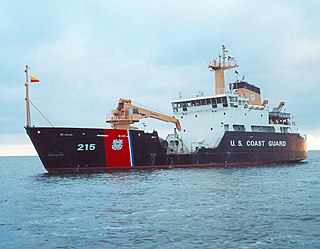
USCGC Sequoia (WLB-215) is a United States Coast Guard 225-foot Seagoing Buoy Tender, homeported in Apra Harbor, Naval Base, a deep-water port on the western side of the United States territory of Guam.

USCGC Cactus (WLB-270) is a 180 feet (55 m) seagoing buoy tender (WLB). A Cactus-class vessel, she was built by Marine Ironworks and Shipbuilding Corporation in Duluth, Minnesota. Cactus's preliminary design was completed by the United States Lighthouse Service and the final design was produced by Marine Iron and Shipbuilding Corporation in Duluth. On 31 March 1941 the keel was laid, she was launched on 25 November 1941 and commissioned on 1 September 1942. The original cost for the hull and machinery was $782,381.

Sassafras is a C-Class, 180 ft, seagoing buoy tender constructed for the USCG by Marine Iron & Shipbuilding Corp. of Duluth, Minnesota. Sassafras was one of 39 tenders commissioned for duties that would include aids-to-navigation, ice breaking, search-and-rescue, fire fighting, law enforcement, providing fuel and potable water, and assistance to the National Oceanographic and Seismographic Survey.

The U.S. Coast Guard Cutter Oak is a United States Coast Guard seagoing buoy tender; the second of her name and the eleventh of the Juniper class. Home ported in Newport, Rhode Island the "Maine Responder" maintains Aids to Navigation (ATON) along the rugged New England coastline, promoting economic security through navigation safety of the Marine Transportation System. A multi-mission platform, the cutter can also support search & rescue, domestic icebreaking, living marine resources maritime law enforcement, environmental protection, national defense and homeland security missions. The cutter occasionally assists with maintenance support of the National Oceanic and Atmospheric Administration (NOAA) National Data Buoy Center's offshore weather buoys.

USCGC Woodbine (WAGL-289/WLB-289) was a United States Coast Guard buoy tender.

USS Seize (ARS-26) was a Diver-class rescue and salvage ship commissioned in the United States Navy during World War II. Her task was to come to the aid of stricken vessels.
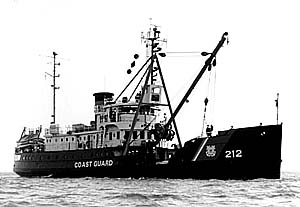
The United States Coast Guard Cutter Fir was the last lighthouse tender built specifically for the United States Lighthouse Service to resupply lighthouses and lightships, and to service buoys. Fir was built by the Moore Drydock Company in Oakland, California in 1939. On 22 March 1939, the U.S. Lighthouse Tender Fir was launched. She was steam driven with twin screws, 175 feet (53 m) in length, had a beam of 32 feet (9.8 m), drew 11 feet 3 inches (3.43 m) of water, and displaced 885 tons. Fir was fitted with a reinforced bow and stern, and an ice-belt at her water-line for icebreaking. She was built with classic lines and her spaces were lavishly appointed with mahogany, teak, and brass. The crew did intricate ropework throughout the ship. The cost to build Fir was approximately US$390,000. Fir's homeport was Seattle, Washington for all but one of her fifty one years of service when she was temporarily assigned to Long Beach, California when USCGC Walnut was decommissioned on 1 July 1982.

USCGC Woodrush (WLB-407) was a buoy tender that performed general aids-to-navigation (ATON), search and rescue (SAR), and icebreaking duties for the United States Coast Guard (USCG) from 1944 to 2001 from home ports of Duluth, Minnesota and Sitka, Alaska. She responded from Duluth at full speed through a gale and high seas to the scene of the SS Edmund Fitzgerald sinking in 1975. In 1980, she took part in a rescue rated in the top 10 USCG rescues when she helped to save the passengers and crew of the cruise ship Prinsendam after it caught fire in position 57°38"N 140° 25"W then while being towed sank off Graham Island, British Columbia. She was one of the first vessels to respond to the Exxon Valdez oil spill in 1989. She was decommissioned on 2 March 2001 and sold to the Republic of Ghana to serve in the Ghana Navy.

USCGC Sycamore (WLB-209) is a United States Coast Guard seagoing buoy tender, the second of her name and the ninth of the Juniper-class. She is now home-ported in Newport, Rhode Island, following a one year long Midlife Maintenance Availability (MMA) in Baltimore, Maryland. She was originally home-ported in Cordova, Alaska. Sycamore primarily tends to aids-to-navigation (ATON) in Martha's Vineyard, the Long Island Sound, Hudson River, and New York City Harbor and entrances; however she is also responsible for maintenance support of National Data Buoy Center's offshore weather buoys. In addition to her primary ATON role, Sycamore also performs other duties, such as, marine environmental protection, maritime law enforcement, domestic icebreaking, search and rescue, and homeland security missions.
USCGC Clover WAGL/WLB/WMEC-292, a Cactus (A) Class buoy tender was built by Marine Iron and Shipbuilding, Duluth, Minnesota. Her keel was laid 3 December 1941, and she was launched 25 April 1942. She was commissioned on 8 November 1942 in the United States Coast Guard as the United States Coast Guard Cutter Clover. She was built as a WAGL, redesignated a WLB in 1965, and again redesignated a WMEC in 1979.

The USCGC Willow (WLB-202) is a United States Coast Guard seagoing buoy tender, the third of her name and the second of the Juniper-class. She is home-ported in Charleston, South Carolina, where she replaced her sister ship USCGC Oak in servicing 257 aids to navigation in District 7. Willow's area of operations stretches from South Carolina down to Caribbean, including Puerto Rico, Cuba, U.S. Virgin Islands and Haiti. In addition to her primary aids-to-navigation (ATON) role, Willow also performs other duties, such as maritime border security, marine environmental protection, maritime law enforcement, and search and rescue. The Willow transitioned from her former home port of Newport, RI in 2017 after spending over a year in a Baltimore dry dock being refitted and modernized.

USCGC Aspen (WLB-208) is the eighth cutter in the Juniper-class 225 ft (69 m) of seagoing buoy tenders. She is under the operational control of the Commander of the Eleventh U.S. Coast Guard District and is home-ported at Yerba Buena Island in San Francisco, California. Her primary area of responsibility is the coastal waters, river bars and high seas from the California–Oregon border to San Diego, California. Aspen conducts heavy lift aids-to-navigation operations, and law enforcement, homeland security, environmental pollution response, and search and rescue as directed.

USCGC Walnut (WLB-205) is the fifth cutter in the Juniper-class 225 ft (69 m) of seagoing buoy tenders and is the second ship to bear the name. She is under the operational control of the Commander of the Fourteenth Coast Guard District and is home-ported on Sand Island in Honolulu, Hawaii. Her primary area of responsibility is the coastal waters and high seas around the Hawaiian Islands and American Samoa. Walnut conducts heavy lift aids-to-navigation operations, and law enforcement, homeland security, environmental pollution response, and search and rescue as directed.
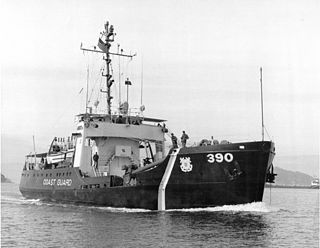
The USCGC Blackhaw (WLB-390) was a Iris-class buoy tender belonging to the United States Coast Guard launched on 18 June 1943 and commissioned on 17 February 1944.

USCGC Firebush (WLB-393) was an Iris-class buoy tender belonging to the United States Coast Guard launched on 3 February 1944 and commissioned on 20 July 1944. She was eventually transferred to the Nigerian Navy in June 2003 and renamed Nwamba.
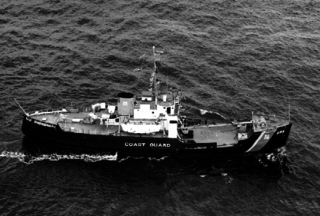
The USCGC Iris (WLB-395) was a Iris-class buoy tender belonging to the United States Coast Guard launched on 18 May 1944 and commissioned on 11 August 1944.

The USCGC Mallow (WLB-396) was a Iris-class buoy tender belonging to the United States Coast Guard launched on 9 December 1943 and commissioned on 6 June 1944.
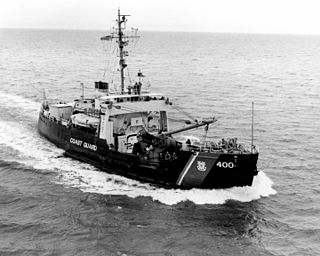
USCGC Salvia (WLB-400) was a United States Coast Guard Iris-class buoy tender in commission from 1944 to 1991. She operated in the Great Lakes and along the United States Gulf Coast during her career. Sold and renamed Brian Davis in 2020 for use as a memorial vessel, she was scuttled as an artificial reef in 2020.

USS YF-339 was an American YF-257-class covered lighter built in 1944 for service in World War II. She was later acquired by the United States Coast Guard and renamed USCGC White Bush (WAGL-542).

USS YF-446 was an American YF-257-class covered lighter built in 1943 for service in World War II. She was later acquired by the United States Coast Guard and renamed USCGC White Lupine (WAGL-546).



















